I recently discovered celeriac, also known as celery root, and was curious about its taste and texture. Celeriac is a root vegetable that is part of the celery family.
It has a knobby, rough, and brown exterior with a creamy white interior.
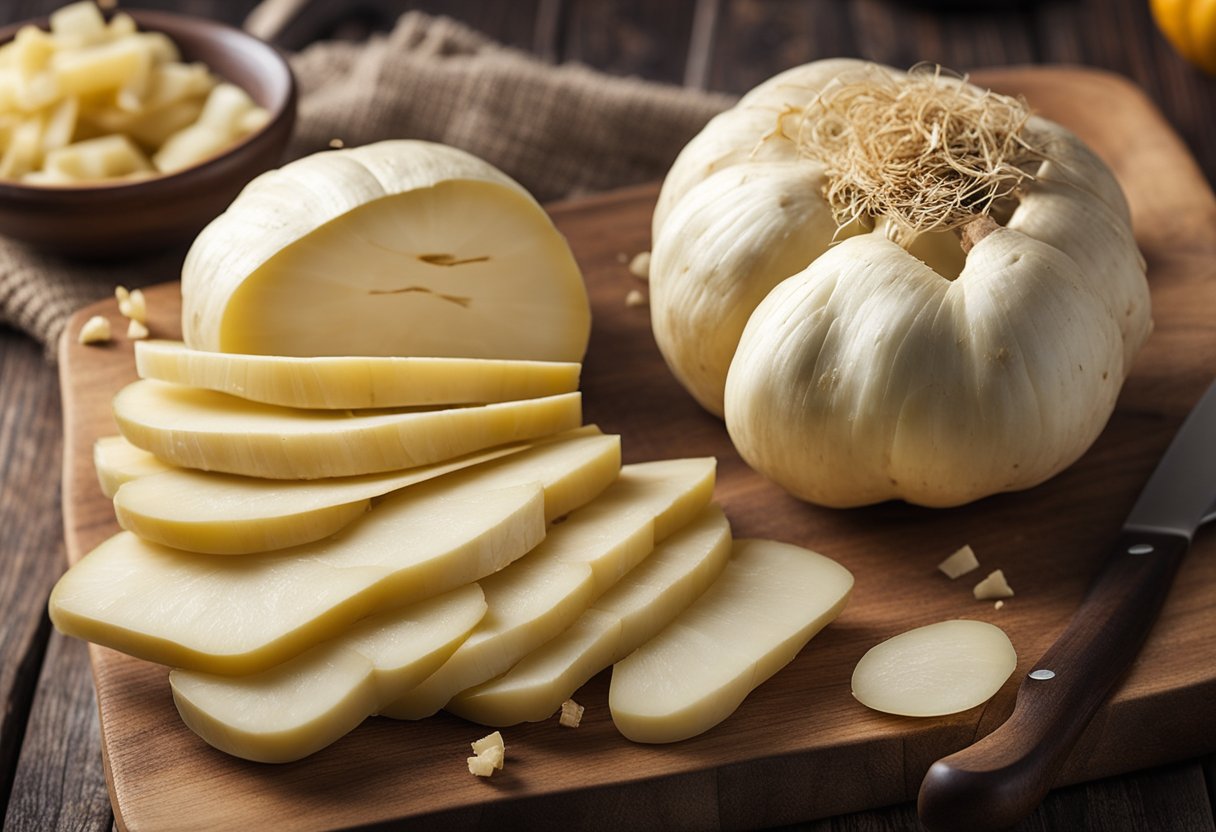
When I first tasted celeriac, I noticed its distinct earthy taste and slight hint of celery flavor. Its texture is firm and slightly crunchy, making it a great addition to salads, soups, and stews.
I was intrigued by its unique taste and texture and wanted to learn more about this versatile vegetable.
Key Takeaways
- Celeriac has a distinct earthy taste and slight hint of celery flavor.
- Its texture is firm and slightly crunchy, making it a great addition to salads, soups, and stews.
- Celeriac is a versatile vegetable that can be prepared in many ways and offers numerous health benefits.
Understanding Celeriac
As a chef, I have come across many different types of vegetables, but celeriac has always been one of my favorites.
Celeriac is a root vegetable that is also known as celery root, knob celery, or turnip-rooted celery. It is part of the celery plant family, but unlike celery, celeriac is grown for its root rather than its stalks.
Celeriac has a rough, knobby exterior that is often removed before cooking. Once peeled, the flesh inside is creamy white and has a dense texture.
The flavor of celeriac is often described as a cross between celery and parsley, with a slightly nutty taste.
One of the great things about celeriac is its versatility. It can be eaten raw or cooked, and it can be used in a variety of dishes.
When raw, celeriac has a refreshing crunch and a mild celery flavor with a little bitterness. It can be grated and used in salads or slaws, or sliced and served with dips.
When cooked, celeriac takes on a sweeter flavor and becomes tender and creamy. It can be roasted, boiled, mashed, or pureed and used in soups, stews, or casseroles.
Celeriac can also be used as a substitute for potatoes in dishes like gratins or mashed potatoes.
In terms of nutrition, celeriac is a good source of fiber, vitamin C, and potassium. It is also low in calories, making it a great choice for those who are watching their weight.
Overall, celeriac is a delicious and versatile vegetable that is often overlooked in the produce aisle. If you haven’t tried it yet, I highly recommend giving it a try.
Taste and Texture of Celeriac
Celeriac, also known as celery root, is a root vegetable that is often used in soups, stews, and purees. It has a unique taste and texture that sets it apart from other vegetables.
The taste of celeriac is often described as earthy and nutty, with a slight hint of celery and parsley. It has a mild sweetness that becomes more pronounced when it is cooked.
The texture of celeriac is firm and crunchy when raw, but becomes smooth and creamy when cooked.
When eaten raw, celeriac has a refreshing and crisp texture that is similar to celery. It can be sliced thinly and added to salads or slaws for a crunchy texture.
When cooked, celeriac becomes tender and creamy, making it an excellent addition to soups and stews.
The earthy taste of celeriac makes it a great complement to other root vegetables like carrots and parsnips. It can also be used as a substitute for potatoes in mashed potato recipes, adding a unique flavor and texture to the dish.
Overall, celeriac is a versatile vegetable that has a distinct taste and texture. Whether eaten raw or cooked, it is a flavorful addition to any dish.
Comparing Celeriac to Other Vegetables
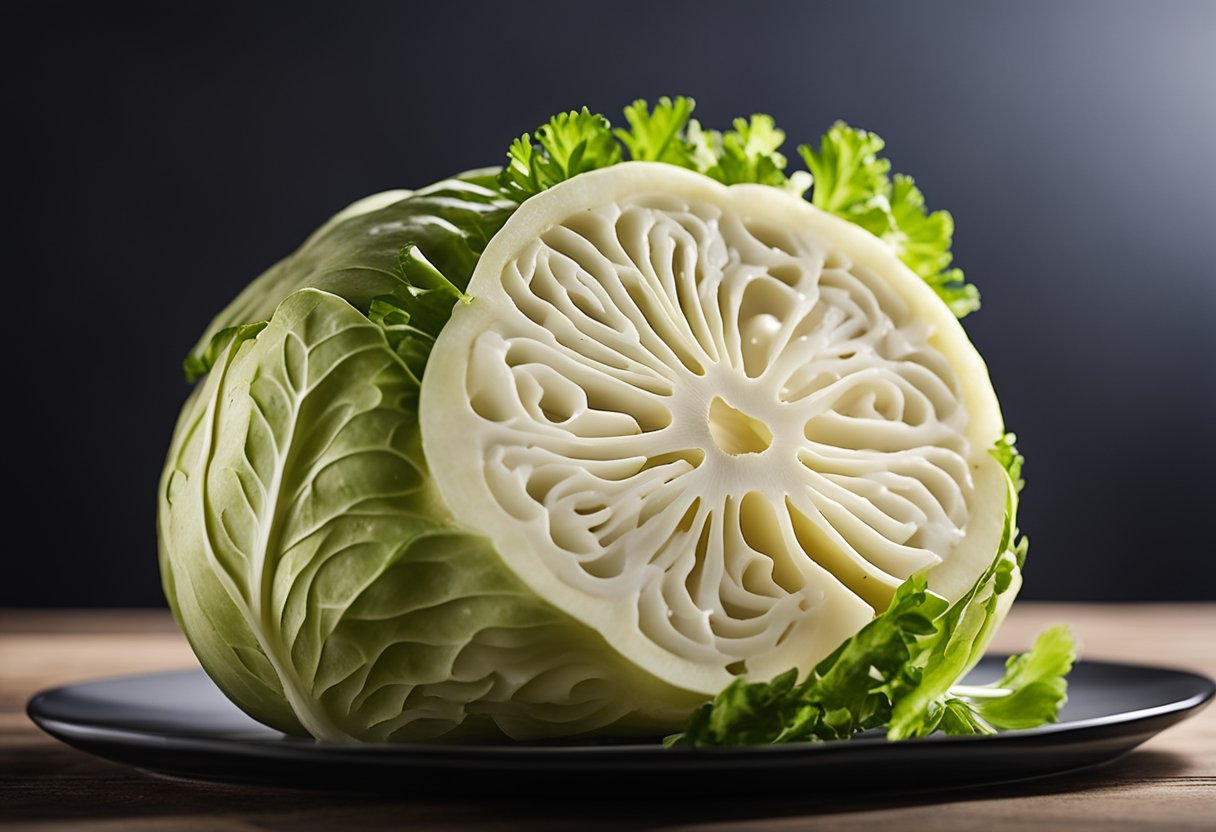
As a root vegetable, celeriac has a unique taste that sets it apart from other vegetables. However, it shares some similarities with other root vegetables like turnips, potatoes, carrots, and parsnips.
Here’s how celeriac compares to these vegetables in terms of taste and texture:
- Turnips: Turnips have a slightly bitter taste and a crunchy texture. Celeriac, on the other hand, has a nutty and earthy taste with a hint of celery-like freshness. Its texture is softer and creamier than turnips.
- Potatoes: Potatoes have a mild taste and a starchy texture. Celeriac has a more complex taste that is nutty, earthy, and slightly sweet. Its texture is also creamier and less starchy than potatoes.
- Carrots: Carrots have a sweet and slightly earthy taste with a crunchy texture. Celeriac has a similar earthy taste but is less sweet. Its texture is softer and creamier than carrots.
- Parsnips: Parsnips have a sweet and nutty taste with a slightly woody texture. Celeriac has a similar nutty taste but is less sweet. Its texture is creamier and less woody than parsnips.
- Radishes: Radishes have a peppery and slightly bitter taste with a crunchy texture. Celeriac has a nutty and earthy taste with a softer texture. Its taste and texture are quite different from radishes.
Overall, celeriac has a unique taste and texture that sets it apart from other root vegetables.
While it shares some similarities with other vegetables, it has a distinct flavor profile that is nutty, earthy, and slightly sweet. Its texture is also creamier and softer than most root vegetables.
How to Select and Store Celeriac
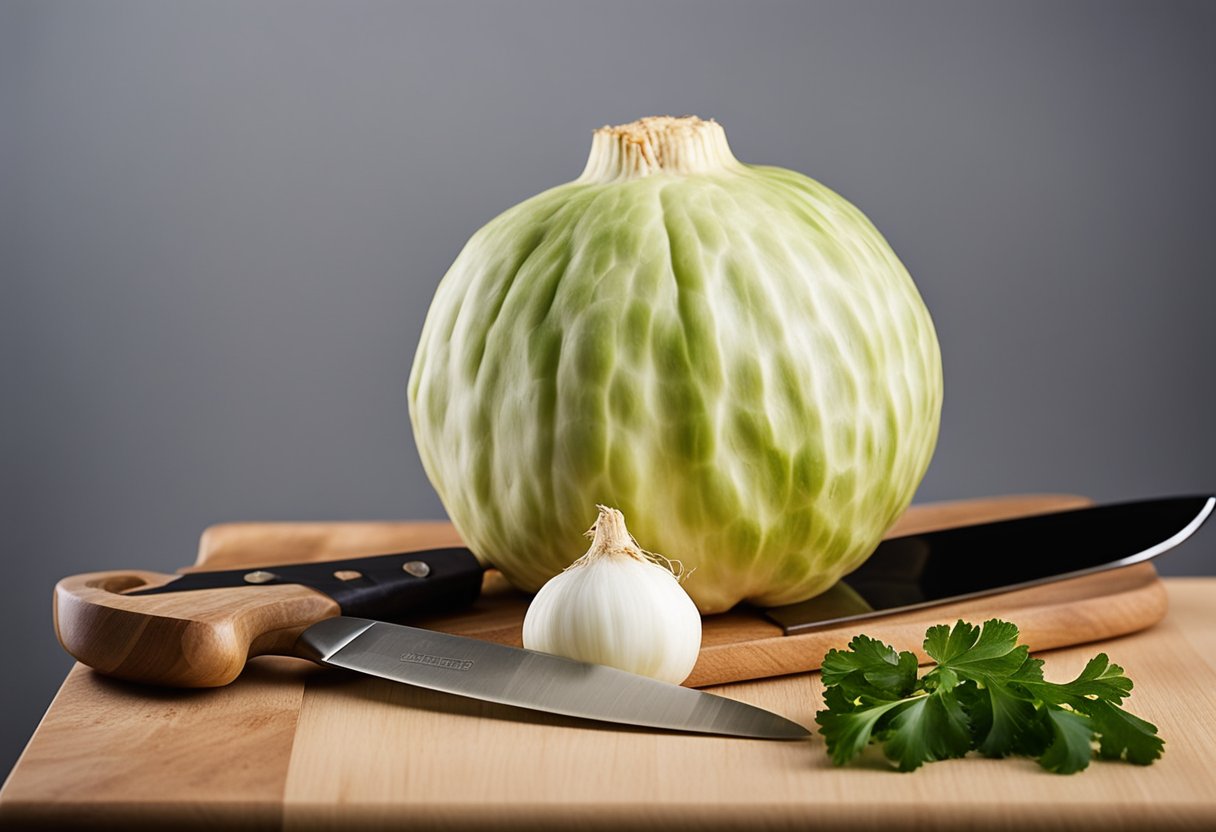
When selecting celeriac, it is important to choose firm, unblemished roots that are heavy for their size. Look for celeriac that is free of cracks, bruises, and soft spots. A heavy celeriac root indicates that it is fresh and has not dried out.
Celeriac can be found in the produce section of most grocery stores. It is typically sold loose and not pre-packaged. When selecting celeriac, choose a root that is about the size of a grapefruit. Larger roots tend to be tougher and less flavorful.
To store celeriac, wrap it in a damp paper towel and place it in a plastic bag in the refrigerator. Celeriac can be stored for up to a week in the fridge.
Make sure to keep it away from ethylene-producing fruits and vegetables, such as apples and bananas, as they can cause celeriac to spoil more quickly.
If you are storing celeriac for an extended period, you can also store it in a cool, dark place, such as a root cellar or pantry. Keep in mind that celeriac stored outside of the refrigerator may dry out more quickly and lose some of its flavor.
In summary, when selecting celeriac, look for firm, unblemished roots that are heavy for their size. Store celeriac in the refrigerator wrapped in a damp paper towel and plastic bag, away from ethylene-producing fruits and vegetables.
Celeriac can also be stored in a cool, dark place for an extended period, but may dry out more quickly and lose some of its flavor.
Preparation Methods for Celeriac
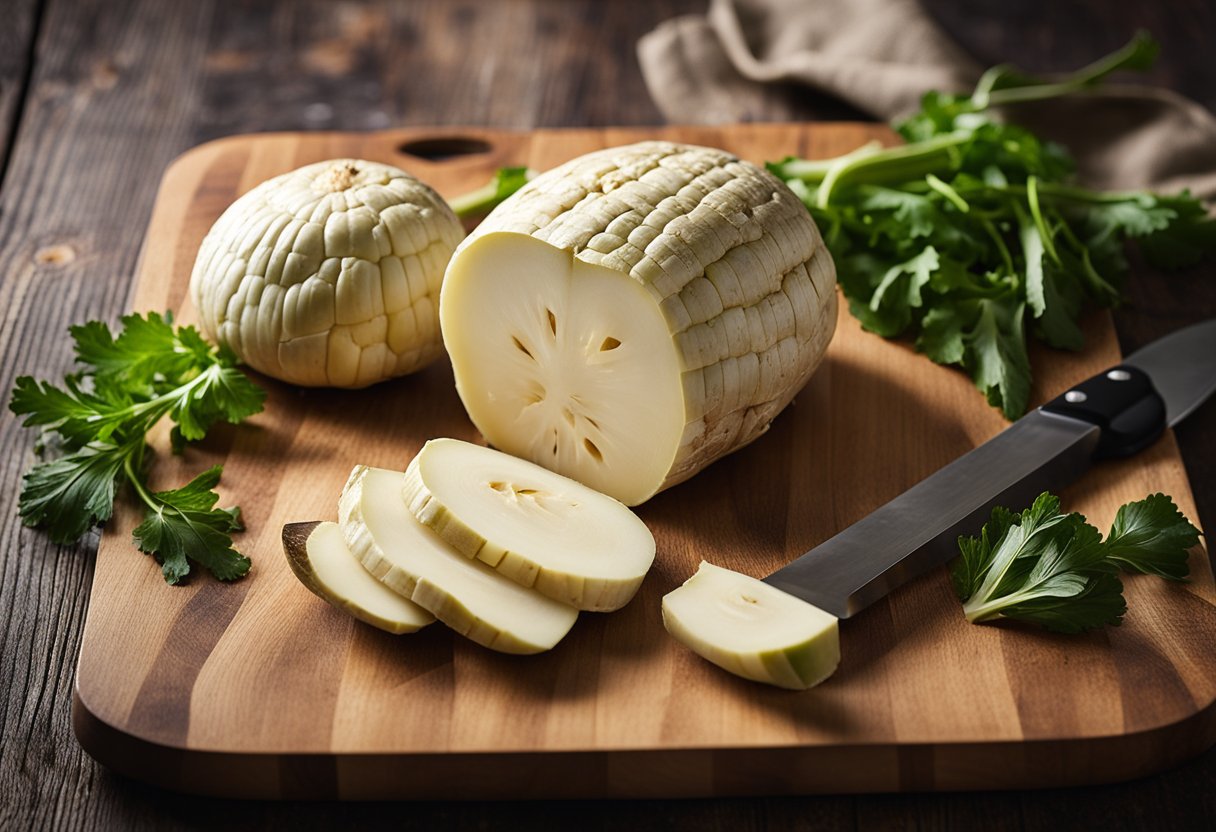
As with any vegetable, the way celeriac is prepared can greatly affect its taste and texture. Here are some common methods for preparing celeriac:
Peeling
Before using celeriac, it is important to peel it first. The outer layer is tough and not edible. To peel celeriac, use a sharp knife or a strong peeler.
Cut off the top and bottom of the celeriac, then slice off the skin in sections, working from top to bottom.
Chopping and Slicing
Celeriac can be chopped or sliced into various sizes and shapes depending on the recipe. For example, it can be sliced thinly for use in salads, or chopped into cubes for use in stews or soups.
When chopping, it’s important to use a sharp knife to ensure clean cuts and prevent any accidents.
Grating
Celeriac can also be grated and used as a base for coleslaw or other salads. To grate celeriac, use a box grater or a food processor with a grating attachment. Be sure to remove any excess water before using the grated celeriac in your recipe.
Dicing
Diced celeriac is a great addition to roasted vegetables or can be used as a substitute for potatoes in a mash. To dice celeriac, slice it into thin planks, then cut those planks into sticks, and finally cut those sticks into cubes.
Cooking
Celeriac can be cooked in a variety of ways, including roasting, sautéing, boiling, or mashing. It pairs well with a variety of flavors, such as garlic, thyme, and rosemary.
When cooking celeriac, it’s important to keep an eye on it as it can become mushy if overcooked.
Overall, celeriac is a versatile vegetable that can be used in a variety of dishes. By using the right preparation method, you can enhance its flavor and texture.
Cooking with Celeriac
I love cooking with celeriac because it has a unique flavor that is perfect for a variety of dishes. Here are some ways to cook with celeriac:
Raw
When eaten raw, celeriac has a refreshing crunch with a mild celery flavor. It pairs well with other raw vegetables in salads or slaws.
Try shredding it finely and mixing it with carrots, apples, and a light vinaigrette for a delicious and healthy salad.
Boiled or Steamed
Boiling or steaming celeriac is a great way to cook it for use in mashed potatoes or purees. The texture is similar to that of a potato, but with a slightly sweeter flavor.
Simply peel and chop the celeriac into small pieces, then boil or steam until tender. Mash or puree with butter, cream, and seasonings for a delicious side dish.
Sautéed
Celeriac can also be sautéed for a tasty side dish or garnish. Cut it into small cubes or thin slices and sauté in olive oil or butter until tender and lightly browned. Season with salt, pepper, and herbs for added flavor.
Roasting
Roasting celeriac brings out its natural sweetness and gives it a crispy texture. Cut it into wedges or cubes, toss with olive oil and seasonings, and roast in the oven until golden brown. Serve as a side dish or use in soups and stews.
Soups and Stews
Celeriac is a great addition to soups and stews. Its earthy flavor adds depth to the dish, while its texture holds up well in the broth. Try adding it to a creamy root vegetable soup or a hearty beef stew for a delicious and satisfying meal.
Fries
Celeriac fries are a healthier alternative to potato fries. Cut the celeriac into thin strips, toss with olive oil and seasonings, and bake in the oven until crispy. Serve with your favorite dipping sauce for a tasty snack or side dish.
Remoulade
Remoulade is a classic French sauce made with mayonnaise, mustard, and pickles. Adding shredded celeriac to the mix gives it a unique flavor and texture. Use it as a topping for sandwiches or burgers, or serve as a dip for vegetables or crackers.
Overall, celeriac is a versatile and delicious vegetable that can be used in a variety of dishes. Whether you cook it raw or use it in soups and stews, celeriac is sure to add flavor and nutrition to your meals.
Seasoning and Pairing Celeriac
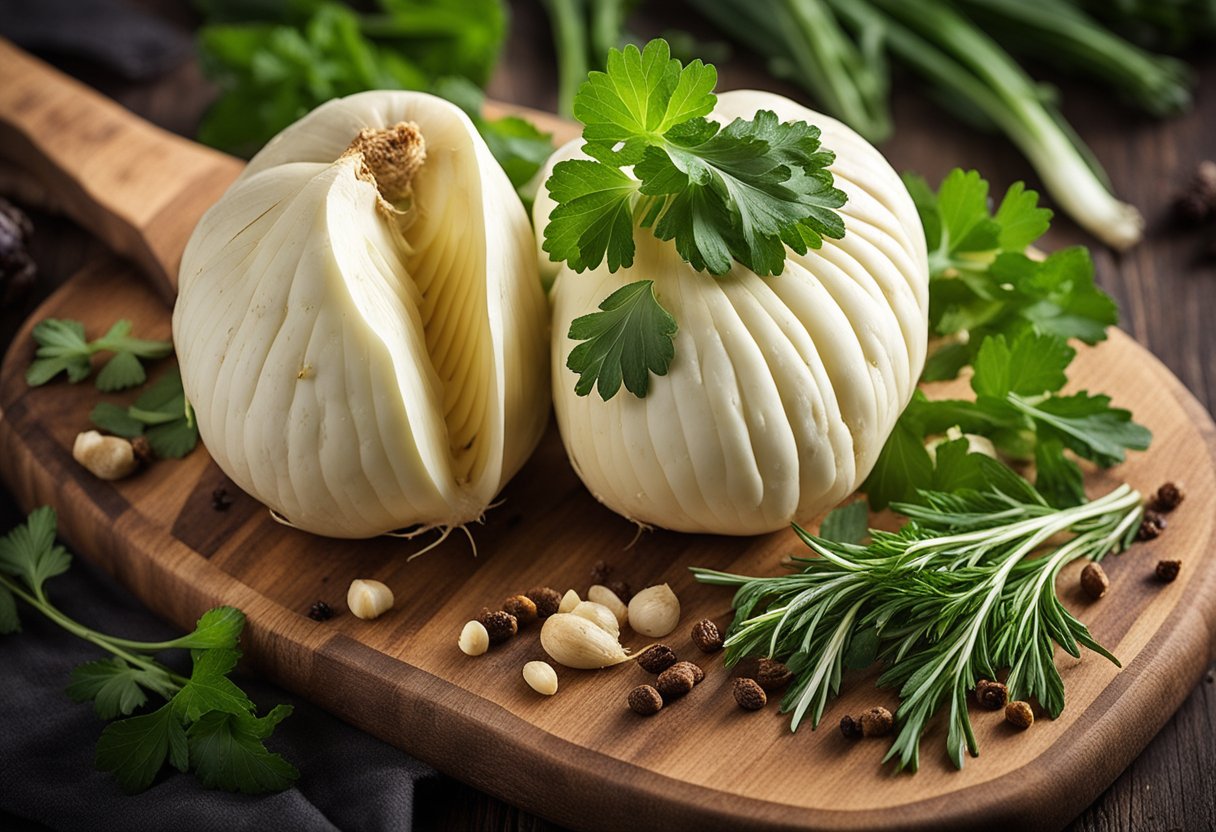
When it comes to seasoning celeriac, it is important to keep in mind its unique flavor profile. Celeriac has a subtle celery flavor with a slightly sweet and nutty taste.
It pairs well with a variety of seasonings and spices, including salt, pepper, butter, vinegar, olive oil, parsley, and lemon juice.
One simple way to season celeriac is with salt and pepper. This brings out the natural flavors of the vegetable and adds a bit of depth to the dish.
Another option is to use butter or olive oil to add richness and a bit of creaminess to the celeriac.
For those who prefer a bit of tanginess, vinegar or lemon juice can be used to brighten up the dish. This is particularly popular in European cuisine, where celeriac is often served as a side dish or used as a base for soups and stews.
When pairing celeriac with other ingredients, it is important to keep in mind its subtle flavor. Celeriac pairs well with a variety of meats, including chicken, beef, and pork.
It also works well with other vegetables, such as carrots, onions, and potatoes.
For a simple and flavorful side dish, try roasting celeriac with olive oil, salt, and pepper. For a more complex dish, celeriac can be used as a base for soups and stews, or even grated and used in salads.
Overall, celeriac is a versatile vegetable that can be seasoned and paired with a variety of ingredients. With its unique flavor and texture, it is a great addition to any meal.
Health Benefits and Nutritional Value of Celeriac

As a nutritionist, I can confidently say that celeriac is a nutritional powerhouse that offers several health benefits.
It is a great source of fiber, vitamins B6, C, and K, phosphorus, potassium, and antioxidants. It is also low in carbs and high in water content, making it an excellent choice for those who want to maintain a healthy weight.







